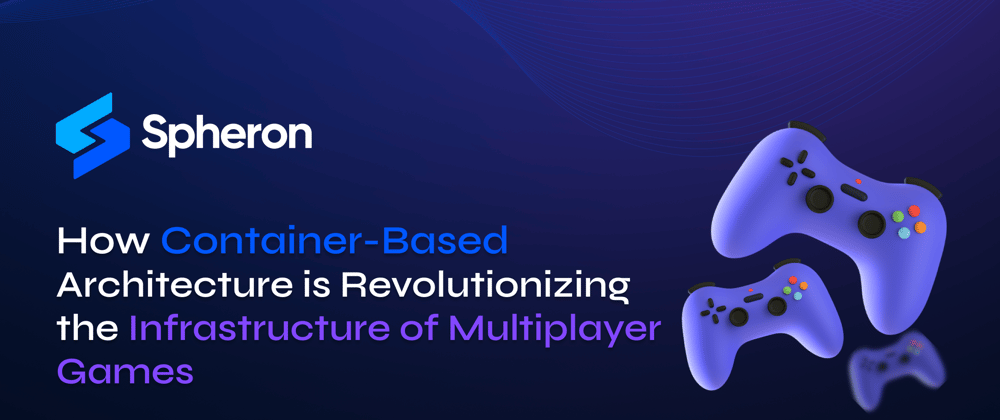Introduction
Ever since my childhood, I've been enamored by video games from pixelated adventures to today's vast, interconnected worlds. While the nostalgia of simpler games remains, the present-day multiplayer experiences are on a different scale entirely. As I transitioned from a gamer to an engineer, a burning question arose: "How do these games seamlessly cater to millions worldwide?"
During the initial phases, games operated on localized servers or individual devices where a host runs the server, and anyone can connect to the host to play the game. Serving a global audience is still hard to achieve with this approach, hindered by issues like latency, scalability, and inconsistent environments. The very thought of seamlessly catering to millions of players worldwide seemed nearly impossible.
However, the introduction of containerized-based architecture brought global scalability and efficient delivery from the cloud. It enables so many opportunities that were not possible with older approaches.
Evolution of Multiplayer Game Architecture
Lets rewind a bit and reminisce about the early days of multiplayer gaming. Remember when you'd boot up a game and had to pick a region first? Or even further back, those days when one of us had to volunteer our computer to host the game, letting everyone else join the session?
So, what was happening behind the scenes? Let me break it down with an architecture diagram.
As illustrated, this setup is termed a 'peer-to-peer' network. In this model, any player can step up to become the host. Their machine essentially becomes the game server, allowing others to connect and start the game. Behind the scenes, this temporary server syncs with a central database housed in the game company's data warehouse. This method was quite cost-effective for companies, as they werent shouldering the expense of maintaining dedicated game servers.
However, this approach wasnt without its pitfalls. Scalability was a consistent pain point, deployment was cumbersome, and taking a game global using this model presented significant hurdles.
In the earlier days of game development, deploying on dedicated servers was an uphill battle. Picture this: games sprawled across numerous servers worldwide, each needing individual attention for hardware and software configurations.
Without today's sophisticated deployment tools, each game update was a laborious manual task. Syncing a new feature or patch across countless servers was not just tedious but prone to errors, leading to extensive downtimes and frustrated players. Scaling was another beast entirely. Predicting player demand was tricky; overestimations meant wasted resources on underused servers, while underestimations resulted in overloads and lag. The entire process was a DevOps nightmare, with manual checks and fixes being the norm. It's a testament to how advancements like containerization have transformed the gaming infrastructure landscape.
Consider Minecraft as an illustration. The game operates on a client-server model. While Mojang, the company behind Minecraft, operates its own official servers, they have also open-sourced the server software. This empowers the community to host their own servers, tailored with diverse mods and rules, and even to invite friends to join their unique worlds. A significant enabler of this widespread server hosting is the containerization of the server software. This encapsulation simplifies the process, allowing enthusiasts to run servers without delving deep into the complexities of the code, just like how you can do through Spheron Marketplace.
Container-Based Architecture: A Primer
When one looks at the evolution of game development, the progression is fascinating. Navigating the maze of infrastructure once presented a significant challenge for many developers. However, the introduction of containers signified a transformative moment in game infrastructure management.
Previously, developers had to manage cumbersome, extensive server configurations. With containers, these compact solutions modularized and streamlined those hefty setups. With containerized environments, theres an assurance of game consistency, regardless of the phase be it during rigorous development or in an active gaming environment.
For DevOps teams across the industry, containers brought about a sea change. Updates? Just adapt the relevant container. An anomaly in a particular section? There is no need for a full system revamp; focus on rectifying that container. This modular approach drastically reduces downtimes and mitigates performance inconsistencies.
Instead of maintaining and running vast server configurations all the time, resources can now be adjusted dynamically based on player traffic demand with load balancers, effectively distributing user requests and ensuring a seamless gaming experience, all the while optimizing operational costs.
To sum it up, the introduction of container technology has redefined efficiency, scalability, and cost dynamics in game development.
The Revolution Begins: Benefits for Multiplayer Games
Alright, the revolution is here. Since we know what are the benefits of containers for multiplayer games. Lets dial down to the major benefits we get and explain them a bit more on how you can get these benefits for your games.
We're aware that containers inherently run on the same OS kernel, which can optimize resource usage while isolating the application processes from each other. This means game servers can run multiple game sessions or services on a single physical server without interference. For example, think of a game with different modules (chat service, game logic, player statistics). Rather than dedicating a whole server to each module, multiple containerized modules can coexist efficiently on one server, thus optimizing resource usage.
To further provide optimization of resources, some orchestration like Kubernetes provide built-in load balancers to instantly scale up or down based on traffic. If a game suddenly experiences a player surge, new container instances can be spun up almost instantly. This orchestration also provides encapsulation on the servers environment, ensuring that the software runs consistently across various stages from development to production. For example, a game developer tests a new bug or patch in a container on their local machine. Once tested, they can be confident that the feature will behave the same way in the live environment without disrupting gameplay for users.
Many modern DevOps teams opt for containers mainly because they facilitate smooth deployments. As each feature or service is isolated, developers can deploy updates, test new features, or roll back problematic releases without significant downtimes. With all these benefits, developers can now bring architecture to the next level by breaking down monolithic game server code into smaller, modular microservices. Each aspect of the game can be developed, deployed, and scaled independently.
The adoption of containers in game development doesnt just make technical sense; it brings about a transformation that significantly enhances end-users gaming experience and streamlines developers' development and deployment process.
The Roadblocks: Challenges in Containerizing Multiplayer Games
Containers offer a groundbreaking approach to game development, but they're not without challenges. This transient nature poses challenges when youre dealing with stateful applications or components, like a player's saved game data or in-game assets. To solve this, you can always use persistent DBs like MongoDB, Postgres DB, or sticky sessions for a user to have a perfect game session running in multiple containers.
Moreover, while containers are designed to be lightweight, they can sometimes introduce latency, which, in the gaming realm, can be a deal-breaker. Think of those crucial moments in fast-paced games; even a minor delay can drastically affect gameplay. You can handle latency by deploying different instances in different locations to reduce latency.
Furthermore, the shift to a container-based infrastructure isn't straightforward. It requires a paradigm shift in how developers and operations teams think about application deployment and scaling. There's a learning curve involved in understanding container orchestration, networking, security, and more. Also, to overcome this steep learning curve, there are lots of orchestration platform like Spheron that helps developers deploy their game infrastructure on an easy-to-use container service. Spheron also provides lots of tooling required for games at any scale to deploy their service on containers without needing to learn much.
Looking Ahead: What's Next in the Container Revolution
The fusion of containers and cloud gaming is the next big thing, and it's easy to see why. As cloud gaming services like Google Stadia, NVIDIA GeForce Now, and Xbox Cloud Gaming gain traction, the importance of seamless, scalable, and responsive infrastructure becomes paramount. Given the containers lightweight, scalable, and modular nature, they can seamlessly integrate into cloud gaming platforms. This means near-instant booting up of games, more efficient resource utilization, and the ability to serve games to myriad devices without a hitch. Imagine being able to play the latest AAA game on your smartphone with the same fluidity and richness as on a high-end gaming rig; containers in cloud gaming can make this a reality, enhancing user experiences manifold.
But it's not just about the cloud; the entire ecosystem around containerized gaming is burgeoning. From specialized tools that aid in container orchestration to platforms optimized for gaming workloads like Spheron , theres a growing suite of resources tailored for the gaming industry. Additionally, vibrant communities of developers and enthusiasts are contributing to this domain, sharing innovations and best practices and continuously refining the technology. These collective efforts are paving the way for games that are more robust, scalable, and globally accessible.
In a nutshell, as the gaming industry continues to evolve, containers are set to play a starring role. Their integration into cloud gaming and the burgeoning ecosystem around them signifies not just the future of gaming infrastructure but a promising evolution in how we play and experience games.
Conclusion
From the nostalgic pixelated escapades of yesteryears to todays sprawling multiplayer realms, our gaming journey has been an exhilarating quest. As we transitioned from 2D realms to lifelike 3D worlds, we now stand poised at yet another paradigm shift: the transformative impact of container-based architecture, which is redefining the very core of multiplayer gaming.
No longer are we merely spectators to this evolution; the stage is set for every game developer, infrastructure engineer, and enthusiast to be a part of this. As the lines between physical gaming consoles blur and cloud gaming gains momentum, containers are ensuring that every player's experience is seamless and unparalleled. This isnt just about the next technical upgrade; it's an open invitation to be part of gamings most ambitious chapter yet.
Ready Player One? Dive into this revolution because the next level promises to be beyond imagination!










Top comments (0)